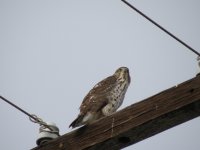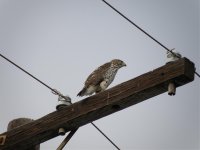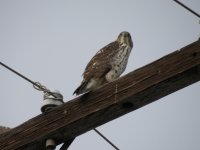Over the last few months I have noticed a semi-large, what I thought at the time was a Falcon, I'm legally blind and you will agree when you see the photos;-) I did some Googling and I think these birds are Broad Winged Hawks which there is a parent bird and two juveniles. Of late (a week) I have only seen the youngins but not the parent bird. I have found photos on the Internet of Broad-Winged Hawks that are an exact copy of my b irds I have photographed but then I would see other photos of B-W Hawks and they look nothing like mine! So I'm gonna let the experts decide. I live in the suburbs of Los Angeles in the San Fernando Valley in Granada Hills. What I have read is that if these are Broad-Winged Hawks they are on the wrong side of the States, they don't usually make it west of Texas. They seem to be very rare here in Southern California. These birds are out on the poles every morning and evening plus I hear them all day long because they are very vocal especially when the Mocking birds are bothering them. So, I'm going to leave it up to the Hawk experts to decide what they are.
Thanks Joe




Thanks Joe









